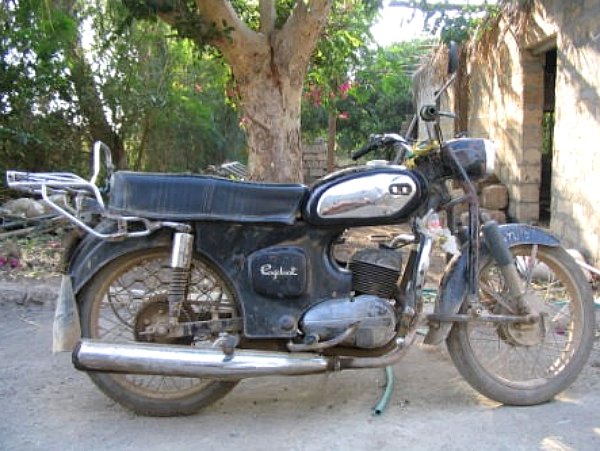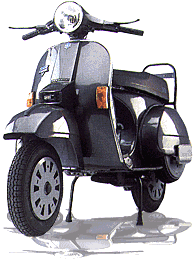Motorcycling in India
Motorcycling Indian Style
Hello from Sly, your roving reporter this time bringing you the motorcycling news all the way from India!
The first thing you notice about biking in India is…. Traffic! It would be impossible to jam 1 billion people into such a small area and not expect a little congestion. Add to this a road system that doesn’t have big budgets to improve traffic flow, so the locals come up with their own system, which is to behave in the same way as water does flowing down a river. If there is a little gap you fill it, then move with the flow in a liquid form.
Lanes? Well sure they have lines painted on the roads, but nobody knows why! Thank goodness the English road infrastructure survives in the calmer areas like New Delhi; a haven of semi-normality from the insanity of the narrow streets of Old Delhi.
On top of all this chaos, you squeeze 100 bicycle style rickshaws (called Tuk-Tuk) and then another 500 3 wheeled golf buggy styled, 2 stroke wheezing “auto rickshaws” as the locals call them. Feed these through streets crowded with people pushing wagons, little skinny horses pulling wagons, the occasional camel hauled wagon, then to top it all off, let Brown’s cows loose from their paddock to wander the streets looking for food and by “divine intervention” give them priority and right of way over everything else, and you will soon understand the excitement (frustration?) of motorcycling in India.
I would not recommend racing down the street on your Triumph Rocket III as it could be possible to disappear up the biggest and slowest of road hazards, Elephants! (When passing one in my auto-rickshaw once I imagined the back wheel of my mate Wizard’s “Rocket III” poking out under the tail.)
See: http://www.auto-rickshaw.com/
Life in India is of the “no frills” variety and everything has a strict purpose. Having a bike for fun or to look cool is something that just doesn’t happen, (hence no Triumphs). Getting to be cool usually means you have managed to upgrade your old 125cc to a 175cc engine and buying your bike, is a long term investment and it’s still common place to see bikes built in the 1960’s and 70’s still used for everyday commuting, and even heavy haulage with the most amazing loads ingeniously attached to the bike.
A large population comes with a huge market, which has seen most of the common motorcycle manufacturers set up an Indian division where bikes are built under license from the parent company. For example there is the highly successful Bajaj Pulsar which has it’s roots with Kawasaki, the popular Honda Hero, the TVS (Suzuki) which produced the Scooty 50 scooter, which was acclaimed as affordable transport for Indian families, producing a bike in 1980, and others. Most of these bikes built around the popular configuration of a single cylinder 4 stroke engine of around 125cc, and designed strictly around the most important factor, cost of running. But there are other companies such as the famous Royal Enfield and the Rajdoot which wasn’t so popular, but very interesting none the less.
Rajdoot Motorcycles
The Escorts group is one of India’s highly diversified engineering conglomerates manufacturing a wide range of tractors, automotive components, railway equipment and construction & material handling equipment. The motorcycle division manufactured bikes under the brand name Rajdoot from the late 1950s. It was a remake of the German DKW RT 125 with an enlarged 175cc engine, which had the reputation of being good for carrying heavy loads, and these bikes are still seen on the streets today.

Rajdoot 350
Later the Escorts group built what was arguably the most successful 2 stroke bike built in India, the Rajdoot 350. It was a licensed copy of the Yamaha RD350-B and was in production from 1983 to 1990. Even though the production of the aircooled Yamaha RD350 had ended in Japan in the mid 1970s due to stringent emissions, it was a technically advanced motorcycle in the Indian market in 1983, and featured the Yamaha patened torque induction system with reed valves and 6 speed transmission. It’s popularity faded due to the high running costs as Escorts service network was not so good in those days. Procuring Parts was difficult and expensive. Fuel consumption too was high and that was considered quite an uphill task as most of the customers couldn’t afford these running costs.
Royal Enfield
Ask any young Indian biking lad (wannabe hoon…) and he will tell you he was considering buying an Enfield, but had to compromise on price and usually ended up with a Japanese copy bike. Saying that, there are plenty of old Enfields about in the big city, and if you look hard, can even find the odd one in the smaller towns too. When I arrived in Delhi I excitedly started to count them and saw my first Royal Enfield was a police bike painted in a disgusting mustard yellow color. Then I saw a nice silver one, a red one, then another, and another and before I knew it I was up to more than 20 bikes and gave up… There are just too many!! How did they become so popular?
In 1890, the Enfield Cycle company, a small English engineering establishment building bicycles, got into some financial trouble and accepted a contract to manufacture rifle parts for the Royal small arms Factory in Enfield England. Like other bicycle manufacturers (Triumph included!) they later turned their hand to motorcycles, as was the fashion of the day.
Royal Enfield (England) had been selling motorcycles in India since 1949. But when the Indian government placed an order for 800 Royal Enfield 350cc bullets for police, army and border patrols, 2 local engineering companies joined forces to become Enfield India where the motorcycles were assembled under license. In 1957 tooling equipment was sold to Enfield India so that they could manufacture components. The first machines were assembled entirely from components shipped from England, but by 1962 all components were made in India. The Indian Enfield uses the 1960 engine (with metric bearing sizes), in the pre-56 design frame.
With its small arms roots, the tank usually bears a logo with a cannon stating “Built like a gun, goes like a bullet”. In the great crumbling of motorcycle production in England, the English Royal Enfield factory at Bradford-on-Avon closed in 1970, but with production still going strongly in India, and again becoming popular in the world of retro motorcycling, the Royal Enfield is the oldest motorcycle model in the world still in production and Bullet is the longest production run model, with the Enfield name now spanning three centuries!
While I was there, I visited an interesting fellow who sources 1960’s and 70’s Enfields (350cc) strips them down and rebuilds them on order for customers overseas (many have gone to Australia) with brand new components and finished off as you request. He also of course, throws away the 350cc barrel and fits a 500cc engine which is more in line with demands outside India. (Contact me if you require more details on this, although he is not geared up for mass production, and delivery is not something that will happen quickly)
But more interesting, he also has a fleet of overhauled vintage Enfield bikes and hires them out for Indian adventure trips. It cost a little over $300 (aud) per week but could make an interesting adventure which I could be talked into if a few others where keen to do it.
Further Reading:
http://en.wikipedia.org/wiki/Royal_Enfield
Scooters
I touched briefly on this subject when I mentioned TVS Scooty 50, but scooters, a vehicle the whole family can go to town on, are far too popular for me not to mention with some detail. There were some Lambretta and Vespa’s kicking around, but the most highly acclaimed name among scooter manufacturers in the country is LML India.
LML Limited is the company that changed the face of scootering in India in collaboration with Piaggio. Now, this company has entered the motorcycle market in collaboration with Daelim of Korea. Now LML scooters are no longer branded as Vespa they still continue to provide the same high quality scooters under the LML name. The company has a marketing and exporting network in various countries like in Italy, UK, USA etc.
In India, LML India has a 30% market share in volume terms with its popular scooter brand “Supremo” which is most noticeable by the sound of its amazing horn, a very important accessory on any vehicle in India. The Supremo horn has the sound crossed between a very wet fart and a very sick duck and you usually here this sound when walking in crowded market places only to turn around a see a thick set man with a big turban on his head speed through the crowd with people fearing for their lives jumping out of his way.
A trip to India is an amazing experience, but don’t treat it like a holiday. Its hard work and an adventure all the way with rewards waiting around every corner. The Taj Mahal is the most beautiful thing I have ever seen and photos just cant capture the magic it holds. You must see it with your own eyes. Then to see public cremations on the steps of the Ganges River too is amazing. With the culture, the sights, sounds, history and architecture of India, I would recommend anyone to make a visit to this fascinating place. And its all possible by motorcycle!
Cheers and happy biking, SLY
Further Reading:
http://www.surfindia.com/automobile/motorcycle-models.html
http://www.caradvice.com.au/9266/indian-maker-tata-launches-2850-car/
